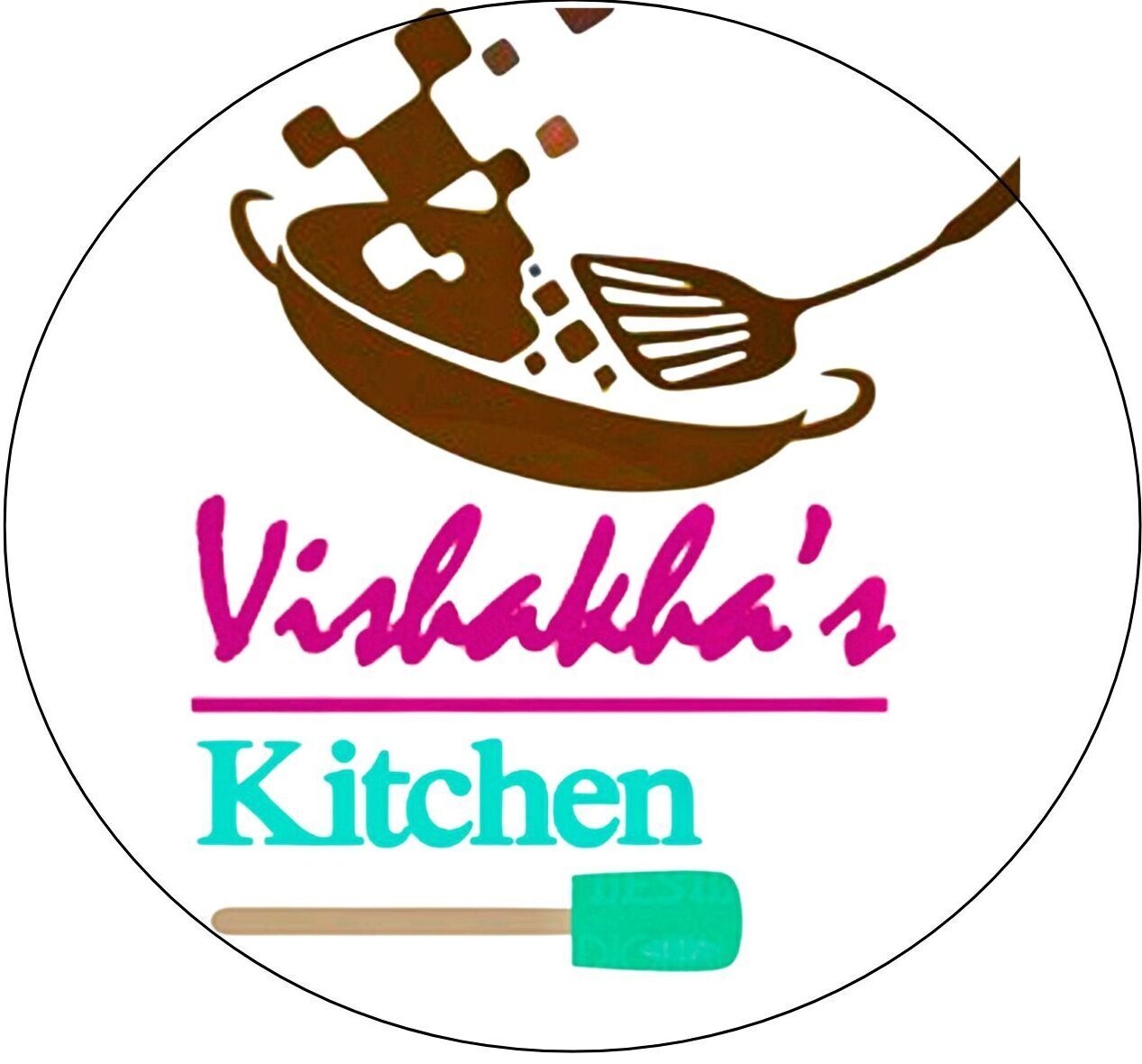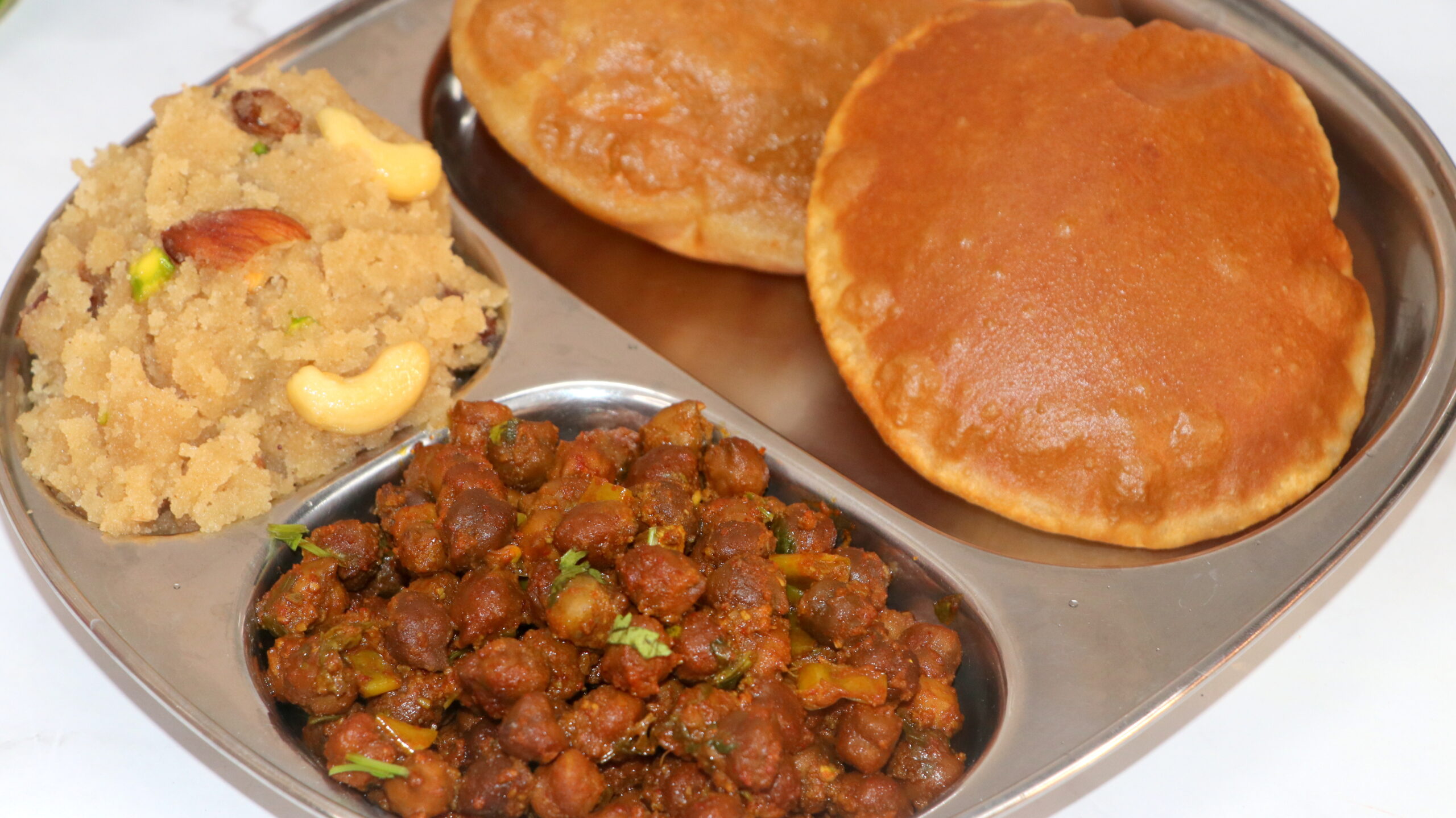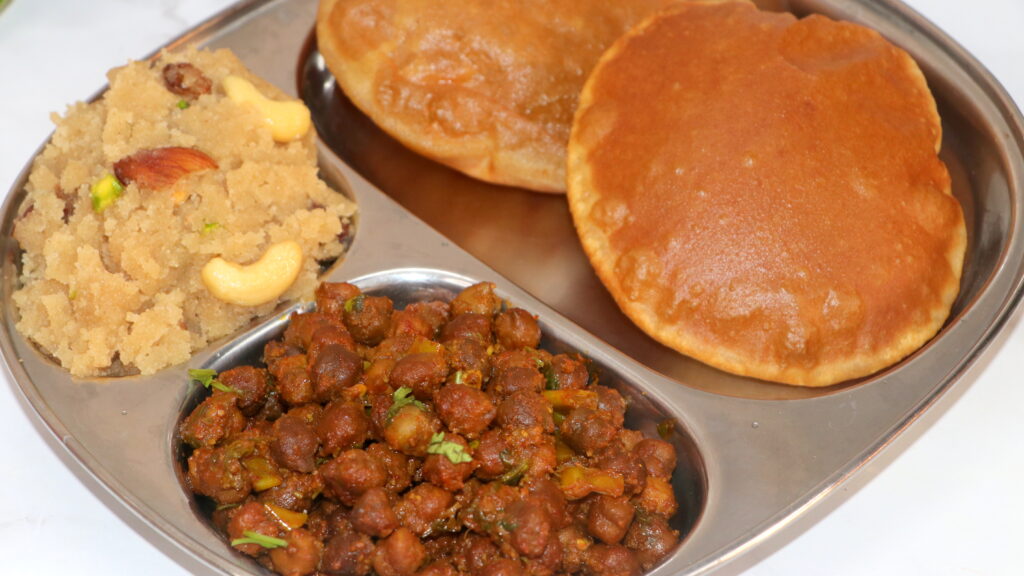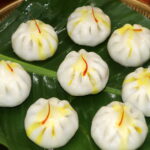During Navratri, particularly on Ashtmi or Navami, we embrace the essence of devotion and celebration, honoring Mata Rani with offerings that reflect out love and gratitude. At our home we do nine days worship Dura maa, we do havan, kanya poojan, we prepare Ashtami prasad suji ka halwa, poori, kala chana and kheer on this auspicious day. This occasion is not just about food, it’s a sacred ritual that celebrates the divine feminine and pays homage to Goddess Durga, symbolizing strength and nurturing.
This day holds a special significance as we perform Kanya poojan, where we honor young girls, recognizing them as symbol of the goddess. Offering these Prasad items to them is a beautiful gesture, expressing our reverence and love.
Today, we will prepare three delightful dishes that are easy and quick to make, starting with the sweet and rich Suji ka halwa.. Suji ka halwa, also known as semolina halwa or sheera, is a traditional Indian sweet dish that is both comforting. Its rich flavor, combined with the aromatic touch of cardamom and the crunch of nuts, make it a beloved offering during festivals and special occasions.
Along with the sweetness of Suji ka halwa, we will also prepare Kale Chana (black chickpeas), which add a savoury element to our feast. Rich in protein and fiber, they are not only healthy but also incredible flavourful
No festive meal is complete without the fluffy and golden Pooris right??
These deep fried Indian breads are the perfect accompaniment to out sweet and
savoury dishes..
Let’s prepare it all three dishes at this auspicious day.
Ingredients
1) Suji ka Halwa :
- Semolina (Suji) – ½ cup
- Ghee – ½ cup
- Sugar – ½ cup (can use organic sugar for a healthier option)
- Water – 2 cups (you can also use milk for a richer taste)
- Chopped nuts – 2 tablespoons (cashews, almonds, pistachios, raisins)
- Saffron – A few strands (optional, for color and flavor)
- Cardamom powder – ¼ teaspoon
Method
- Firstly, heat a pan add ½ cup of ghee on low flame.
- Now add the chopped cashews, almonds, pistachios and raisins to the ghee. Fry them until they turn golden brown color. This enhances their flavour and adding a nice crunch to the halwa.
- Once done, remove them from the pan and set aside.
- In the same pan with the remaining ghee, add 1 tbsp of besan (gram flour) for extra taste. Mix well
- Gradually add ½ cup of semolina or rava, stirring continuously. Ensure that the flame is on low heat. Roast the semolina until it turns a light golden color and releases a nutty aroma. This step is very important it enhances the flavour of the halwa.
- Meanwhile, bring 2 cups of water to a boil in a separate pot. If you prefer a creamier texture, you can use milk instead of water.
-
Now carefully pour the boiling water into the roasted semolina, stirring continuously to avoid lumps. Be cautious, as the water may splatter.
-
Once the water is absorbed by the semolina, add the saffron strands (optional) and ½ cup of sugar. Stir well to combine. The halwa will become slightly liquidy at this point, which is normal.
-
Now cover the pan with a lid and let it cook on low flame for about 3 – 4 minutes. This helps the semolina absorb the sweetness and the flavour of the saffron also.
-
After 3 – 5 minutes, check the halwa. It should be soft and moist. Add the fried nuts and ¼ tsp of cardamom powder. Mix everything well.
-
Finally. turn off the flame, and let the halwa rest for a few minutes before serving.
2) Kale Chana :
- Kala Chana: 1 cup (soaked overnight)
- Green cardamom: 2
- Cinnamon stick: Small piece
- Turmeric powder: 1/8 tsp
- Oil: ¼ tsp
- Ghee: 2 tbsp
- Cloves: 2
- Red chili powder: 1 tsp
- Kashmiri red chili powder: 1 tsp
- Cumin powder: 1 tsp
- Coriander powder: 1 tbsp
- Sugar powder: 1 tsp
- Sendha namak: To taste
- Green chilies: 2, slit
- Grated ginger: ½ tsp
- Fresh coriander leaves: 1 tbsp, chopped
- Firstly, in a pressure cooker add the soaked 1 cup chana, pour enough water, 2 cardamoms, a piece of cinnamon, turmeric powder, and little oil into it. Cook for 3 whistles and let pressure release naturally.
- Next, take a bowl add 1 tsp red chili powder, 1 tsp Kashmiri red chili powder, 1 tsp cumin powder, 1 tbsp coriander powder and 1 tsp sugar with a little water of form a paste.
- Now, heat a kadai add 2 tbsp of ghee or you can use oil also. Add 2 cloves, 2 slit green chilies and 1/2 tsp grated ginger. Saute it.
- Now, add prepared spice paste and saute until oil separates.
- Once the masala is ready, add the boiled chana and sendha namak as per taste. Mix it well.
- If mixture is too dry, add some of the leftover water from cooking the chana. Cover and cook for about 8 – 9 minutes on slow heat.
- Finally garnish with freshly chopped coriander leaves, mix it well and turn off the flame.
- Our kala chana is ready to serve. Lets prepare poori.
3) Poori
- Wheat flour: 1 cup
- Fine semolina: 1 tsp
- Powdered sugar: ½ tsp
- Salt: ¼ tsp
- Water: As required
- Oil: For frying
- In a mixing bowl, combine 1 cup wheat flour, 1 tsp semolina, 1/2 tsp powder sugar and 1/4 tsp sendha namak. Mix it well
- Gradually add water and knead into a soft dough. Cover and let it rest for 10 minutes.
- Divide the dough into small balls and roll them into round shapes, about 1/4 inch thick.
- Now heat a oil in a kadai. Fry each poori on high flame until they puff up and turn golden brown. Drain on paper towels
- Poori is ready
Serve the Suji ka halwa, Kale chana and Pooris together as a special Navratri Prasad. This combination is not only delicious but also filled with love and devotion, perfect for offering to Mata Rani.
I hope you enjoy making and sharing this Navratri special prasad. Happy Navratri!

Vishakha's Kitchen
Join me on a delightful journey through the world of flavors and traditions! At Vishakha's Kitchen




